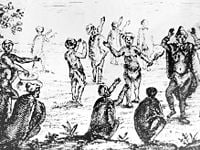Khoikhoi
The Khoikhoi ("men of men"[1]) or Khoi, in standardised Khoekhoe/Nama orthography spelled Khoekhoe, are a historical division of the Khoisan ethnic group of southwestern Africa, closely related to the Bushmen (or San, as the Khoikhoi called them). At the time of the arrival of white settlers in 1652, they had lived in southern Africa for about 30,000 years and practised extensive pastoral agriculture in the Cape region.
Name
They were traditionally — and are still occasionally in colloquial language — known to white colonists as the Hottentots, a name that is nowadays considered offensive by the Oxford Dictionary of South African English. The word "hottentot" meant "stutterer" in the colonists' northern dialect of Dutch, although some Dutch use the verb "stotteren" to describe the clicking sounds (klik being the normal onomatopoeia, parallel to English) typically used in the Khoisan languages. The word lives on, however, in the names of several African animal and plant species, such as the Hottentot Fig, or Ice Plant (Carpobrotus edulis).
History
Khoikhoi social organisation was profoundly damaged and, in the end, destroyed by white colonial expansion and land seizure from the late 17th century onwards, which ended traditional Khoikhoi pastoral life. As social structures broke down, some Khoikhoi people settled on farms and became bondsmen or farmworkers; others were incorporated into existing clan and family groups of the Xhosa people.
Hottentot women were displayed in Europe in the 18th century because of their presumed sexual powers. The most notable of these was a woman known as Saartjie Baartman. In his book Regular Gradations of Man (1799), Dr. Charles White, a historical race scientist, claimed blacks were halfway between whites and apes in the great chain of being. He used the example of Hottentot women to show the supposedly primal sexuality of blacks. White claimed Hottentot women had overdeveloped breasts, showing a more animal nature. Also cited were the elongated labia minora which among Khoisan women could hang down as many as four inches outside the vulva, and steatopygia; their tendency to develop large deposits of fat on their buttocks, in a very specific way far beyond that of Western women[citation needed].
Publications
- P. Kolben, Present State of the Cape of Good Hope (London, 1731-38);
- A. Sparman, Voyage to the Cape of Good Hope (Perth, 1786);
- Sir John Barrow, Travels into the Interior of South Africa (London, 1801);
- Bleek, Reynard the Fox in South Africa; or Hottentot Fables and Tales (London, 1864);
- Emil Holub, Seven Years in South Africa (English translation, Boston, 1881);
- G. W. Stow, Native Races of South Africa (New York, 1905);
- A. R. Colquhoun, Africander Land (New York, 1906);
- L. Schultze, Aus Namaland und Kalahari (Jena, 1907);
- Meinhof, Die Sprachen der Hamiten (Hamburg, 1912);
- Richard Elphick, Khoikhoi and the Founding of White South Africa (London, 1977)
See also
- Herero and Namaqua genocide
- Nama, a branch of the Khoikhoi
- Khoikhoi mythology
- Saartjie Baartman
- History of South Africa
ReferencesISBN links support NWE through referral fees
External links
- Cultural Contact in Southern Africa by Anne Good for the Women in World History website
- An article on the history of the Khoikhoi
- The genetic heritage of one Afrikaner family
Credits
New World Encyclopedia writers and editors rewrote and completed the Wikipedia article in accordance with New World Encyclopedia standards. This article abides by terms of the Creative Commons CC-by-sa 3.0 License (CC-by-sa), which may be used and disseminated with proper attribution. Credit is due under the terms of this license that can reference both the New World Encyclopedia contributors and the selfless volunteer contributors of the Wikimedia Foundation. To cite this article click here for a list of acceptable citing formats.The history of earlier contributions by wikipedians is accessible to researchers here:
The history of this article since it was imported to New World Encyclopedia:
Note: Some restrictions may apply to use of individual images which are separately licensed.


